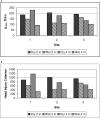The potential for brain injury on selected surfaces used by cheerleaders
- PMID: 19911085
- PMCID: PMC2775360
- DOI: 10.4085/1062-6050-44.6.595
The potential for brain injury on selected surfaces used by cheerleaders
Abstract
Context: Although playground surfaces have been investigated for fall impact attenuation, the surfaces that cheerleaders use have received little attention.
Objective: To determine (1) the critical height for selected surfaces used by cheerleaders at or below which a serious head impact injury from a fall is unlikely to occur, (2) the critical heights for non-impact-absorbing surfaces for comparison purposes, and (3) the effect of soil moisture and grass height on g(max) (which is defined as the multiple of g [acceleration due to gravity at the earth's surface at sea level: ie, 32.2 feet x s(-1) x s(-1)] that represents the maximum deceleration experienced during an impact) and the Head Injury Criterion (HIC) at the critical height for a dry grass surface.
Design: Observational study.
Settings: A local cheerleading gym, indoor locations within the authors' institution, and various outdoor locations.
Main outcome measure(s): g(max), HIC, and critical height.
Results: Critical heights for the surfaces tested ranged from 0.5 ft (0.15 m) for concrete and vinyl tile installed over concrete to more than 11 ft (3.35 m) for a spring floor. Increases in grass height and soil moisture resulted in an increase in the critical height for grass surfaces. Only spring floors and 4-in (0.10-m)-thick landing mats placed on traditional foam floors had critical heights greater than 10.5 ft (3.20 m), thus providing enough impact-absorbing capacity for performance of 2-level stunts.
Conclusions: The potential for serious head impact injuries can be minimized by increasing the shock-absorbing capacity of the surface, decreasing the height from which the person falls, or both. Cheerleaders and cheerleading coaches should use the critical heights reported in this study to compare the relative impact-absorbing capacities of the various surfaces tested, with critical height as an indicator of the impact-absorption capacity of the surface. The findings of this study can be used to select the most appropriate surface for the type of maneuver to be performed, based on the maximum height expected to be achieved by the cheerleader(s) during execution of the maneuver. Cheerleaders should not perform maneuvers at heights that exceed the critical height for the surface on which they are performing.
Keywords: Head Injury Criterion; Triax; critical height; surface impact attenuation.
Figures



Similar articles
-
Epidemiology of cheerleading fall-related injuries in the United States.J Athl Train. 2009 Nov-Dec;44(6):578-85. doi: 10.4085/1062-6050-44.6.578. J Athl Train. 2009. PMID: 19911083 Free PMC article.
-
Shock-absorbing aggregates beneath playground equipment: grain properties and moisture content.Inj Prev. 2018 Jun;24(3):224-231. doi: 10.1136/injuryprev-2017-042335. Epub 2017 Jul 28. Inj Prev. 2018. PMID: 28754662
-
The predicted risk of head injury from fall-related impacts on to third-generation artificial turf and grass soccer surfaces: a comparative biomechanical analysis.Sports Biomech. 2010 Mar;9(1):29-37. doi: 10.1080/14763141003690245. Sports Biomech. 2010. PMID: 20446637
-
Epidemiology of cheerleading stunt-related injuries in the United States.J Athl Train. 2009 Nov-Dec;44(6):586-94. doi: 10.4085/1062-6050-44.6.586. J Athl Train. 2009. PMID: 19911084 Free PMC article.
-
Hazardous chemicals in outdoor and indoor surfaces: artificial turf and laminate flooring.J Expo Sci Environ Epidemiol. 2022 May;32(3):392-399. doi: 10.1038/s41370-021-00396-4. Epub 2021 Oct 25. J Expo Sci Environ Epidemiol. 2022. PMID: 34697408 Review.
Cited by
-
Cheerleading injuries: A narrative review of the literature.J Can Chiropr Assoc. 2012 Dec;56(4):292-8. J Can Chiropr Assoc. 2012. PMID: 23204573 Free PMC article.
-
Simplification and transformation of ASTM F1292 measurement procedure for fall accident injury criteria.Ind Health. 2014;52(5):407-13. doi: 10.2486/indhealth.2014-0096. Epub 2014 Aug 1. Ind Health. 2014. PMID: 25088989 Free PMC article.
-
Cheerleading injuries in children: What can be learned?Paediatr Child Health. 2017 Jun;22(3):130-133. doi: 10.1093/pch/pxx048. Epub 2017 May 5. Paediatr Child Health. 2017. PMID: 29479198 Free PMC article.
-
Understanding the Cheerleader as an Orthopaedic Patient: An Evidence-Based Review of the Literature.Orthop J Sports Med. 2022 Jan 18;10(1):23259671211067222. doi: 10.1177/23259671211067222. eCollection 2022 Jan. Orthop J Sports Med. 2022. PMID: 35083360 Free PMC article. Review.
-
A systematic review of cheerleading injuries: epidemiological characteristics, biomechanical mechanisms, and prevention strategies.Front Public Health. 2025 Jul 9;13:1614164. doi: 10.3389/fpubh.2025.1614164. eCollection 2025. Front Public Health. 2025. PMID: 40703179 Free PMC article.
References
-
- Lewis L. M., Naunheim R., Standeven J., Naunheim K. S. Quantitation of impact attenuation of different playground surfaces under various environmental conditions using a tri-axial accelerometer. J Trauma. 1993;35(6):932–935. - PubMed
-
- Mott A., Rolfe K., James R., et al. Safety of surfaces and equipment for children in playgrounds. Lancet. 1997;349(9609):1874–1876. - PubMed
-
- Robinovitch S. N., Chiu J. Surface stiffness affects impact force during a fall on the outstretched hand. J Orthop Res. 1998;16(3):309–313. - PubMed
Publication types
MeSH terms
Substances
LinkOut - more resources
Full Text Sources
Medical

